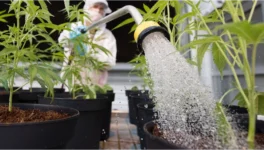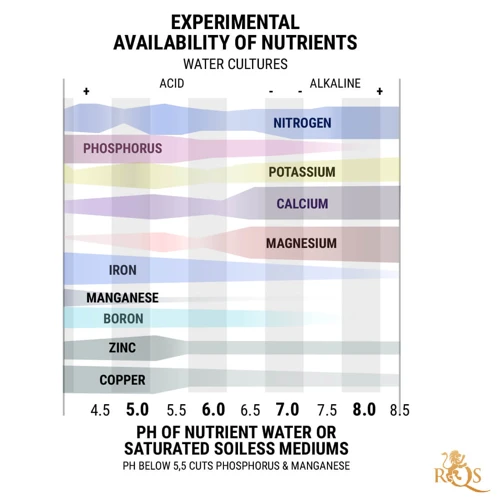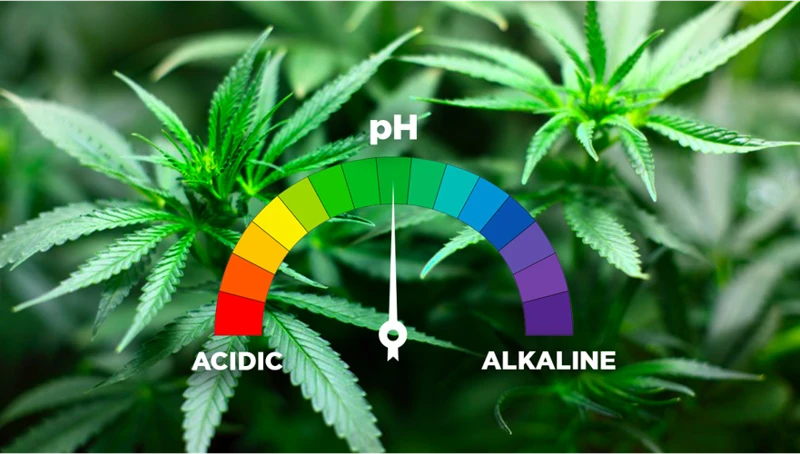
Why Maintaining Proper pH Levels is Critical for Cannabis Growth
As cannabis plants continue to gain popularity for their medicinal and recreational uses, growers are discovering the importance of maintaining proper pH levels when watering their plants. But what exactly is pH and why does it matter for cannabis growth? This article will explore the mysteries of pH levels and their effects on cannabis plants. We’ll delve into how to monitor and adjust pH levels, factors that can affect pH levels, and the benefits of maintaining proper pH levels. Read on to discover the key to robust, healthy cannabis plants.
Understanding pH Levels
Contents
One of the most important factors in successfully growing cannabis plants is understanding the role of pH levels. It’s a critical aspect that requires a basic understanding of chemistry and biology. pH levels can affect the availability of essential nutrients and how the plant absorbs them. In this section, we will explore the concepts of pH levels, their ideal range for cannabis plants, and the effects of incorrect pH levels. Let’s dive into the world of pH levels and discover why they are essential in growing healthy cannabis plants.
What is pH Level?
The pH level is an essential factor to consider when growing cannabis plants. It measures the acidity or alkalinity of a solution, which includes water and soil. The pH level is determined on a scale of 0-14, with a pH of 7 considered neutral.
Acidic solutions have a pH below 7, while alkaline solutions have a pH above 7.
- An acidic pH level: A pH below 7 makes a solution more acidic, which can cause the plant to have problems absorbing nutrients.
- An alkaline pH level: A pH above 7 makes the solution more alkaline and can cause a nutrient-locking-up effect.
Cannabis plants thrive in a specific pH range, and it is crucial to maintain that range for optimum growth and development. If the pH level goes outside of this range, the plant’s ability to absorb essential nutrients will be affected, which can lead to stunted growth or even death.
To ensure your cannabis plants remain healthy and happy, it is vital to regularly check and maintain the pH level of your growing medium.
The Ideal pH Range for Cannabis
When it comes to growing cannabis, maintaining the proper pH levels is crucial for the plant’s health and growth. The ideal pH range for cannabis plants is between 6.0 to 7.0. This is slightly acidic to neutral.
To ensure that the pH levels are within this optimal range, it is essential to monitor the water and nutrient solutions regularly. pH levels that are too high or too low can have adverse effects on the plant’s growth and development.
If the pH level is too high, it can cause nutrient lockout, which means that the plant struggles to absorb essential nutrients from the soil or nutrient solution. This, in turn, can lead to stunted growth and yellowing of the leaves.
On the other hand, if the pH level is too low, it can lead to nutrient toxicity, where the plant absorbs too many nutrients, which can cause burn and damage to the roots. This can also lead to yellowing of the leaves and stunted growth.
It is crucial to note that the pH levels can also vary depending on the growth stage of the plant. During the vegetative stage, the pH range can be slightly higher, around 6.0-6.5. Whereas during the flowering stage, a slightly lower pH range, around 6.0, is optimal.
Maintaining the ideal pH range for cannabis plants is necessary for proper plant growth, nutrient absorption, and overall health. Regular monitoring of the pH levels, and adjusting them as necessary, can help ensure that the plant is thriving and producing high-quality buds.
The Effects of Incorrect pH Levels on Cannabis Plants
When it comes to growing cannabis, pH levels are critical. Incorrect pH levels can have detrimental effects on cannabis plants, leading to stunted growth, nutrient deficiencies, and even plant death. This is because the pH level of the soil and water affects the plant’s ability to absorb and use nutrients properly.
The table below highlights the effects of incorrect pH levels on cannabis plants:
| pH Level | Effect on Cannabis Plants |
|---|---|
| Below 5.0 | Aluminum and manganese are more readily available, leading to toxic build-up in plant tissue. This can cause stunted growth and yellowing of the leaves. |
| 5.0-5.5 | Iron is less available, leading to iron deficiencies and stunted growth. |
| 5.5-6.0 | Ideal range for hydroponic and soilless systems. Nutrient uptake is optimized. |
| 6.0-6.5 | Ideal range for most soil-based systems. Nutrient uptake is optimized. |
| Above 7.0 | Nutrients such as phosphorus, calcium, and magnesium become less available, leading to deficiencies. |
| Above 8.0 | Iron and manganese become almost completely unavailable, leading to severe deficiencies. |
It is clear that maintaining the correct pH level is crucial for healthy cannabis plants. Without proper attention to pH levels, growers may find themselves struggling with nutrient deficiencies and other problems, which can stunt growth and reduce yield.
Monitoring and Adjusting pH Levels
Maintaining the proper pH levels should be a top priority for any cannabis grower, as this can significantly impact the growth and health of the plants. pH levels refer to the level of acidity or alkalinity of the water, and it is crucial to monitor and adjust these levels regularly. However, for beginners, getting started with monitoring and adjusting pH levels can be quite perplexing. In this section, we will explore the process of monitoring and adjusting pH levels in detail, including how to test water pH levels, tools for adjusting pH levels, and proper application of pH adjusting solutions.
How to Test Water pH Levels
When it comes to maintaining the right pH level for your cannabis plants, it is important to know how to test the pH levels of the water you will be using. Testing the pH levels may seem daunting, but it is actually quite easy when you know what tools are needed and how to use them correctly. Follow these simple steps to test the pH levels of your water:
- Get a pH testing kit: A pH testing kit is an essential tool that you will need to accurately measure the pH level of your water. You can purchase a pH testing kit at your local hydroponic store or online. Make sure to get a kit that is specifically designed for testing the pH levels of water.
- Fill a test tube with water: Once you have your pH testing kit ready, fill a test tube with the water that you will be using to water your cannabis plants. Make sure that the water is at room temperature before testing, as temperature can affect the pH level readings.
- Insert the pH test strip into the water: Dip a pH test strip into the water in the test tube. Leave the strip in the water for a few seconds to allow the color to develop.
- Compare the color of the test strip: Once the color has developed on the pH test strip, compare it to the color chart provided with your testing kit. The color on the test strip will correspond with a specific pH level value on the color chart.
- Record and adjust the pH level if necessary: If the pH level is not within the ideal range for cannabis plants (between 6.0 and 7.0), then you will need to adjust the pH level by using pH adjusting solutions.
By following these simple steps, you can quickly and easily test the pH levels of your water and ensure that your cannabis plants are getting the correct pH level they need to grow and thrive.
Tools for Adjusting pH Levels
Maintaining the proper pH level for cannabis plants is essential for their growth and overall health. In cases where the pH level is not within the range, it is necessary to adjust it accordingly. This can be done with the help of various tools that are easily available in the market.
Some of the commonly used tools for adjusting pH levels are:
- pH test kit: The first step in adjusting the pH level is to know the current pH level of the water. A pH test kit helps to measure the pH level accurately. It consists of test strips that are dipped in the water, and the color change indicates the pH level.
- pH adjusting solutions: The simplest way to adjust pH levels is by using pH adjusting solutions. These are easily available in stores and come in liquid or powder form. pH up and pH down solutions are used to raise or lower the pH level, respectively. They are added to the water until the desired pH level is achieved.
- pH meter: A pH meter is another tool that can be used to measure pH levels. It is more accurate than a pH test kit and provides a digital reading. However, pH meters can be expensive and require calibration before use.
- Buffer solutions: Buffer solutions are used to calibrate pH meters and to maintain the pH level of the solution. They are available in different pH levels and are used to standardize pH meters to ensure accurate readings.
It is essential to note that not all of these tools are necessary for adjusting pH levels. A simple pH test kit and pH adjusting solutions can do the job in most cases. However, if accuracy is crucial, then a pH meter or buffer solutions can be used. Always ensure to follow the instructions carefully while using these tools to prevent any errors.
The Proper Application of pH Adjusting Solutions
Maintaining proper pH levels for cannabis plants is essential for healthy growth and maximized yield. Testing water pH levels is important, but sometimes the pH levels are incorrect even with quality water sources. In this case, pH adjusting solutions can be used to bring the pH level within the ideal range for cannabis growth.
The Proper Application of pH Adjusting Solutions
It is important to follow the manufacturer’s instructions when using pH adjusting solutions because improper application can lead to plant damage. Here are some general guidelines to keep in mind:
| Step | Description |
|---|---|
| Step 1 | Fill the reservoir or container with the appropriate amount of water. |
| Step 2 | Add the nutrient solution to the water. |
| Step 3 | Measure the pH level of the water using a pH testing kit. |
| Step 4 | Based on the pH testing results, determine how much pH adjusting solution is needed to bring the pH level to the ideal range for cannabis growth. |
| Step 5 | Add the pH adjusting solution to the water slowly, stirring continuously to ensure proper distribution. |
| Step 6 | Test the pH level again after adding the pH adjusting solution to make sure it is within the ideal range. |
| Step 7 | If the pH level is still not within the ideal range, repeat steps 4-6 until the desired pH level is achieved. |
| Step 8 | Finally, adjust pH levels before every watering to ensure consistent levels for cannabis growth. |
Be careful when adding pH adjusting solutions as adding too much can quickly change the pH levels beyond the ideal range for cannabis growth. It’s always better to add a small amount of solution slowly and check the pH level frequently until it is within the ideal range.
Using pH adjusting solutions can help cannabis growers maintain optimal pH levels for maximum yield and healthy plant growth. By following the proper application guidelines, growers can avoid plant damage and ensure a successful harvest.
Factors Affecting pH Levels
Maintaining the proper pH levels is crucial for the growth and overall health of cannabis plants. However, several factors can affect the pH levels of the water used for irrigation. Understanding these factors can help you anticipate and prevent any pH-related issues that may arise. Here are some of the key factors that can affect the pH levels of the water used for watering cannabis plants.
The Source of Water
The source of water used for watering cannabis plants can greatly affect the pH level. Water from different sources can have varying pH levels due to a number of factors, such as the presence of minerals, chemicals, and pollutants. It is important to determine the pH level of the water source before using it to water cannabis plants. Some sources of water may require more tweaking than others to achieve the desired pH level for cannabis plants.
Factors affecting the pH level of water sources:
- Geography – Water sources located in areas with high mineral content in the soil may have higher pH levels.
- Pollution – Water that has been contaminated by pollutants will often have a lower pH level as it becomes more acidic.
- Industrial waste – Water sources located near industrial areas may have a higher pH level due to the discharge of chemicals and waste by industries.
- Hard water – Water with higher mineral content, particularly calcium and magnesium, is considered “hard water” and may have a higher pH level than softer water.
Knowing the pH level of the water source is crucial in order to make the necessary adjustments before watering the cannabis plants. It is recommended to test the pH level of the water before adding any nutrients or adjusting it with pH adjusting solutions. If the water source has a pH level that is too high, it can be adjusted downwards by adding an acid such as phosphoric acid. On the other hand, if the water source has a pH level that is too low, it can be increased by adding a base such as potassium hydroxide.
The source of water used for watering cannabis plants can greatly affect the pH level. It is essential to test the pH level before making any adjustments to ensure that the cannabis plants receive the optimal pH level in their water supply.
Nutrient Solutions and pH Levels
One critical factor that affects the pH levels of cannabis plants is the use of nutrient solutions. Nutrient solutions are used to provide plants with the necessary minerals and nutrients to support their growth. However, these solutions may have a significant impact on the pH levels of the water used to mix them.
1. The pH Levels of Nutrient Solutions
Nutrient solutions are typically acidic, which means they can lower the pH levels of the water used to mix them. It is crucial to have a clear understanding of the pH levels of the nutrient solutions used in growing cannabis plants to ensure that they do not negatively affect the pH levels of the water.
2. The Interaction Between Nutrient Solutions and Soil pH Levels
The pH levels of nutrient solutions can also have an impact on the pH levels in the soil. If the nutrient solution is too acidic, it can lower the pH levels of the soil. On the other hand, if the solution is too alkaline, it can increase the pH levels of the soil. This interaction is critical to the overall health and growth of the cannabis plants.
3. The Importance of Monitoring pH Levels when Using Nutrient Solutions
It is essential to monitor the pH levels of the water and nutrient solution when growing cannabis plants. Regular testing can help identify fluctuations in pH levels and ensure that any necessary adjustments are made quickly. This monitoring can prevent detrimental effects on the plants and maximize their growth potential.
4. Adjusting pH Levels when using Nutrient Solutions
When nutrient solutions are used, adjusting the pH levels of the water is necessary. The pH levels should be adjusted to ensure that they fall within the ideal range for cannabis plants. If they fall outside this range, nutrient uptake can become inefficient, and plant growth can be affected. Adjusting pH levels may also be necessary to avoid nutrient deficiencies or toxicities.
Nutrient solutions can have a significant impact on the pH levels of the water and the soil. It is important to monitor and adjust pH levels when using nutrient solutions to ensure optimal plant growth and prevent potential issues.
The Growth Stage of Cannabis Plants
The growth stage of cannabis plants is another important factor that affects pH levels. During different stages of growth, the plant’s pH requirements may vary, and it is essential to adjust the pH level accordingly to ensure optimal growth.
Seedling Stage: During the seedling stage, it is crucial to maintain a pH level in the range of 5.5 to 6.5. The young plants are delicate and susceptible to damage, and a pH level that is too high or low can damage the plants’ root systems, affecting their growth.
Vegging Stage: When the cannabis plants enter the vegetative stage, the pH requirements of the plant may shift slightly. During this stage, the pH level should be maintained within the range of 5.5 to 6.8.
Flowering Stage: In the flowering stage, the plant’s pH requirements may vary based on the strain. However, most cannabis strains prefer a slightly lower pH level during flowering, typically between 5.5 to 6.5.
It is essential to monitor the pH levels during each growth stage and adjust accordingly to avoid stressing the plants. Failure to maintain proper pH levels during different growth stages can lead to nutrient deficiencies, poor growth, and yield loss.
To keep track of the pH levels during different growth stages, it is beneficial to use a pH chart or table. Below is a simple example of a pH chart that shows the ideal pH ranges during each growth stage.
| Growth Stage | Ideal pH Range |
|---|---|
| Seedling | 5.5 – 6.5 |
| Vegging | 5.5 – 6.8 |
| Flowering | 5.5 – 6.5 |
Following the ideal pH ranges during different growth stages will help cannabis growers maintain healthy plants and maximize their yields.
The Benefits of Maintaining Proper pH Levels
Maintaining proper pH levels is crucial for the healthy growth of cannabis plants. By providing the ideal pH range for cannabis, growers can unlock a plethora of benefits.
Enhanced Nutrient Availability: When pH levels are within the ideal range, nutrients are readily available to the plant. Nutrients become more accessible to the roots, allowing the plant to take in the necessary nutrients it needs for optimal growth.
Boosted Immunity: Proper pH levels can also enhance the plant’s immunity. When pH levels are off, the plant becomes more susceptible to bacterial and fungal infections. By maintaining a stable pH range, growers can limit the risk of pests and diseases, resulting in healthier plants.
Improved Growth and Yield: Proper pH levels encourage healthier growth and can boost yields. When pH levels are off, the plant struggles to take in sufficient nutrients, leading to stunted growth and lower yields. By maintaining the ideal pH range, growers can improve plant development and increase their yield potential.
Prevent Nutrient Lockout: Incorrect pH levels can cause nutrient lockout, which is when nutrients become bound to the soil, making them unavailable to the plant. This leads to nutrient deficiencies and can significantly impact plant growth. By maintaining proper pH levels, growers can prevent nutrient lockout and ensure that their plants are receiving the necessary nutrients for healthy growth.
Maintaining proper pH levels plays a crucial role in the healthy growth of cannabis plants. By providing the ideal pH range, growers can unlock a plethora of benefits, including enhanced nutrient availability, boosted immunity, improved growth and yield, and prevention of nutrient lockout. Consistently monitoring and adjusting pH levels can help growers achieve optimal plant growth and maximize yield potential.
Conclusion
In conclusion, the pH level of water used to water cannabis plants is crucial to their growth and overall health. It is important to understand what pH levels are and how they can affect the plant. The ideal pH range for cannabis plants is between 6-7. If the pH level is incorrect, it can result in stunted growth, yellowing leaves, root disease, and other negative effects.
It is essential to monitor and adjust the pH levels regularly to ensure optimal growth conditions. Testing water pH levels can be done using simple tools like pH test strips or pH meters. If the pH level is too high or too low, there are various pH adjusting solutions available in the market.
Factors like the source of water, nutrient solutions, and growth stage of the plant can affect the pH levels. It is important to take these factors into consideration when monitoring and adjusting the pH levels.
Maintaining proper pH levels can enhance the absorption of nutrients, promote healthy growth, increase yields, and prevent nutrient deficiencies. In addition, it can help prevent the growth of harmful bacteria and fungi that can be harmful to plants.
In conclusion, by understanding and maintaining proper pH levels, cannabis growers can ensure healthy plants and high-quality yields. Proper pH management is an essential part of cannabis cultivation that should not be overlooked.
Frequently Asked Questions
Why is pH level important in watering cannabis plants?
pH level affects nutrient absorption in cannabis plants. If the pH level is incorrect, the plant may not be able to take in the necessary nutrients, leading to stunted growth and other issues.
What is the ideal pH range for cannabis plants?
The ideal pH range for watering cannabis plants is between 6.0 and 7.0. This range allows for optimal nutrient absorption.
What happens if the pH level is too low?
If the pH level is too low (below 6.0), the plant may not be able to take in important nutrients such as calcium and magnesium, leading to deficiencies and other issues.
What happens if the pH level is too high?
If the pH level is too high (above 7.0), the plant may not be able to absorb certain nutrients such as phosphorus and iron, leading to deficiencies and other issues.
What tools do I need to test pH levels?
To test pH levels, you will need a pH testing kit or pH meter. You can find these online or at a hydroponic gardening store.
What are some ways to adjust pH levels?
You can adjust pH levels using pH adjusting solutions such as pH Up or pH Down, or by adding certain substances such as vinegar or baking soda.
What factors can affect pH levels in water?
The source of water, the nutrients used, and the growth stage of the plant can all affect pH levels in water.
Can pH levels affect the flavor of cannabis?
Yes, pH levels can affect the flavor of cannabis. If the pH levels are unstable, it can lead to a harsh taste and uneven burning.
How often should I test the pH level of water when watering cannabis plants?
You should test the pH level of water each time before watering your cannabis plants, as pH levels can change over time.
Can I use tap water to water cannabis plants?
You can use tap water to water cannabis plants, but it is important to test the pH level and adjust it if necessary. Some tap water may contain high levels of minerals that can affect pH levels and nutrient absorption. Using a filtration system may also be beneficial.





